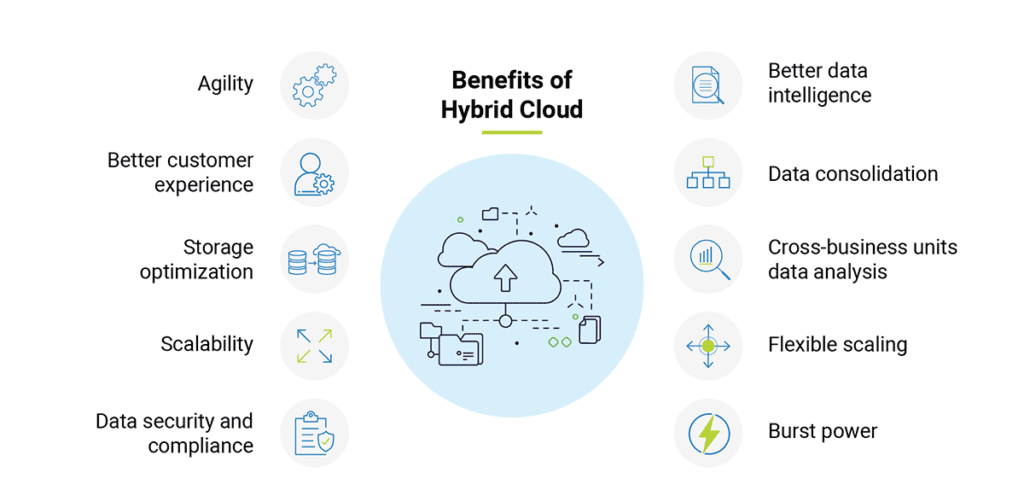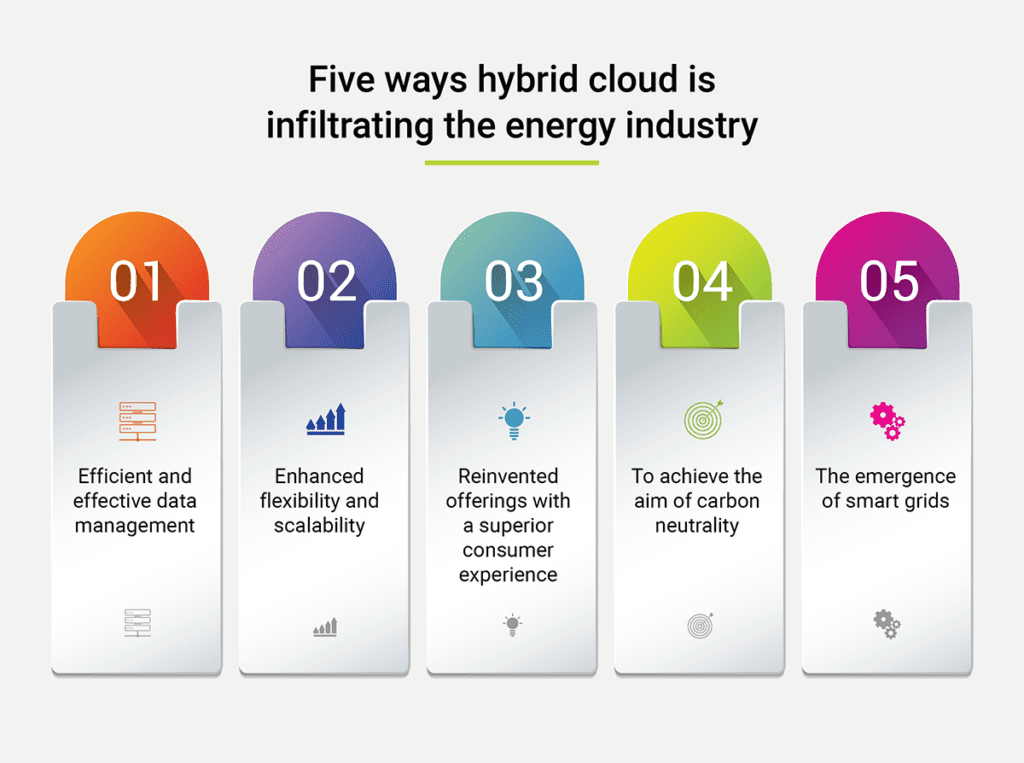Energy is not only changing our lives but also transforming its own!
Originally, solar energy and wind power were among the primary sources of energy, and now we’re turning to them again, albeit with more advanced technologies. The energy industry has progressed significantly from the 1750s, when coal-powered the industrial revolution, to the 2050s, when we strive for net-zero emissions through technological advances. The energy industry is investing in new technologies and digital solutions as part of its sustainability goals, including employing renewable energy sources like solar, wind, hydro, tidal, and geothermal to minimize energy demand and carbon emissions.
With the introduction of renewable energy, distributed grids, and increased customer experience demands, the energy industry is undergoing major changes to move towards green energy. The adoption of cloud technology will hasten this shift, significantly impacting how the energy industry handles asset management, staff health and safety, and field labor management.
So the next question is, what type of cloud computing strategy would be ideal for the energy sector? The scalability and flexibility of a public cloud or the privacy and security of a private cloud?!
Why not combine the best of both worlds with Hybrid Cloud?
The hybrid cloud shares application and data between on-premises, private, and public clouds.

Hybrid clouds allow enterprises to rapidly scale up or down their computing capacity whenever their computing needs exceed the capabilities of on-premises data centers. It also removes the need for excess new servers to be purchased, installed, and maintained.
Data analysis is the first step in adopting hybrid clouds.
Technological advancements and automation in the energy industry produce a vast amount of unstructured data every second. Unlike Industry 3.0, which used computers to improve existing processes, Industry 4.0 aims to reimagine every process around data. Using the right data at the right time and at the right location is the only way to make use of the tremendous amount of data collected every day.
Understanding this unstructured data is the first step in implementing a hybrid cloud.
Here are the top three actions to take while implementing a hybrid cloud:
- Assessment of the data that you have – The energy industry is awash in unstructured data, so it’s important to know what you have. By using metadata or context analysis, it is possible to dig deeper into enterprise data and gain maximum intelligence. For e.g. determining the age of data, file ownership, time of creation, last accessed, file type, size, etc. Content analysis determines which data is sensitive or redundant, trivial, obsolete, hot or cold.
- Adopt the right location for the right data – Compliance, regulatory, and security needs can influence where data and workloads are stored. IT security teams are able to standardize their redundant cloud storage activities with a hybrid environment, which is critical for disaster recovery planning and insurance. In a hybrid cloud, data can, for instance, remain accessible even when an entire data center is down since information is shared across multiple data centers and servers. Additionally, infrastructure is still accessible through the Internet during a disaster.
- Optimize your data storage – Companies who desire more security and control over their data but need a cost-effective way to expand their operations to meet demand spikes can benefit from a hybrid cloud. Identifying business-critical and non-business-critical data is the first step. This can be accomplished using the above steps. The hybrid cloud option allows businesses to keep their core, business-critical, and sensitive data on-premises while offloading less sensitive data and apps to the public cloud.
Click here to check out how Data Dynamics utilized the Azure File Migration Program to help one of the world’s seven multinational energy “supermajors” Fortune 50 companies accelerate its net zero emission goals while driving digital transformation.
5 ways the hybrid cloud is infiltrating the energy industry:

- Efficient and effective data management: With all workflow data available in one place, the hybrid cloud helps expand access to customers globally—including those in locations where data residency requirements and local regulations may affect the use of the global public cloud. A hybrid cloud is designed to reduce analysis time and speed up decision-making. Furthermore, it gives energy companies full interoperability, allowing all applications within the exploration and production (E&P) environment to access their data via one common data ocean, allowing for seamless information sharing across teams. The efficient management of data reduces the time needed to move data between applications, resulting in lower costs and better decision-making.
- Enhanced flexibility and scalability: Upstream energy firms require flexible implementation solutions that regularly enable business expansion, agility, and operational efficiency. Compared to an organization’s on-premise data center, a hybrid cloud provides greater resource possibilities than a public cloud provider. This simplifies providing, deploying, and scaling resources to meet demand spikes. When a company’s local data center capacity is full, it can burst the application or data to the public cloud for more size and capacity. Organizations can transfer workloads between their traditional infrastructure and the public cloud easily.
- Reinvented offerings with a superior consumer experience: In the energy industry, hybrid cloud is compelled to redefine its business models due to the threat of traditional income streams and ever-increasing demand for service experience. The energy industry is pushed to look at new markets and products to re-shape its future in the face of fierce competition. Most of them diversify their product offerings to include solar PV, batteries, electric vehicles, smart homes, and even insurance and broadband plans. In order to succeed, they need a hybrid cloud platform that enables them to quickly launch new products, such as CRM, billing, and smart meters, among other services, while maintaining a best-in-class customer experience.
- To achieve the aim of carbon neutrality: “Moving apps to the cloud might reduce the energy footprint of a workload to one-fifth of that of running the same workload in on-premises data centers,” according to a report by 451 Research (part of S&P Global Market Intelligence). Consolidating on-premises data centers and data lakes into a single data ocean can help cut greenhouse gas emissions, recover power and cooling capacity, restore resilience, lower the total cost of ownership, and minimize energy expenditures.
Microsoft cloud computing uses 93 percent less energy and emits 98 percent fewer greenhouse gases than on-premises data centers. Microsoft enables the use of Data Dynamics for migration into Azure at zero cost. Click here, to know more.
- The emergence of smart grids: To monitor, load balance, and permit two-way power flows, energy and utility companies must develop a sophisticated grid management solution. Making real-time judgments also necessitates capturing and processing real-time data from millions of devices and meters. Running intelligent grids requires a lot of processing capacity that is both reliable and versatile, making it an ideal use case for hybrid cloud adoption.
Data Dynamics is a leading provider of enterprise data management solutions via its Unified Unstructured Data Management Platform. Currently utilized by over 25 Fortune 100 companies, the platform blends automation, AI, machine learning, and blockchain technologies, allowing organizations to use a single software platform to unlock insights, secure data, ensure compliance and governance & drive hybrid cloud data management. Click here to know more about us or email us at solutions@datdyn.com
Check out this recording of our recent webinar with British Petroleum and EDM Council, ‘In the Cloud, Make the Data Reign – Best Practices for Effective Data Management & Migration in a Hybrid Cloud.’
Visit – www.datadynamicsinc.com. Contact us solutions@datdyn.com or click here to book a meeting.






